As the temperatures cool and the days shorten, the leaves of deciduous trees and shrubs begin to change colors in shades of red, orange and yellow.
While many people are familiar with the fall foliage of trees like maples and oaks, there are also several types of shrubs that can turn a brilliant red in the autumn months.
Let us look at why shrubs turn red in the fall and some of the most popular shrubs that turn brilliant red in the fall.
Why do Shrubs Turn Red In The Fall?
Shrubs turn red in the fall as a result of changes that take place within the leaves as the growing season comes to an end. During the growing season, leaves contain high levels of chlorophyll, a green pigment that allows plants to photosynthesize and produce energy from sunlight.
As the days get shorter and temperatures drop in the fall, the production of chlorophyll slows down and eventually stops. As a result, the green color of the leaves fades and other pigments in the leaves, such as carotenoids and anthocyanins, become more visible. These pigments give leaves their red hues.
Anthocyanins are responsible for the red coloration of many fall leaves. These pigments are produced in response to the stresses of the changing season, such as colder temperatures and reduced sunlight.
The intensity of the red coloration is different among different shrubs probably because of factors such as genetics, environmental conditions and the health of the shrub.
List of Shrubs That Turn Red In Fall/Autumn
- Black Chokeberry
- Oakleaf Hydrangea
- Ninebark
- Burning Bush
- Red-Osier dogwood
- Staghorn sumac
- Arrowwood Viburnum
- Highbush Blueberries
- Red Chokeberry
- Smooth Sumac
- Mountain Witch Alder
- Serviceberry
Description of Shrubs that turn brilliant red in Autumn
Black Chokeberry
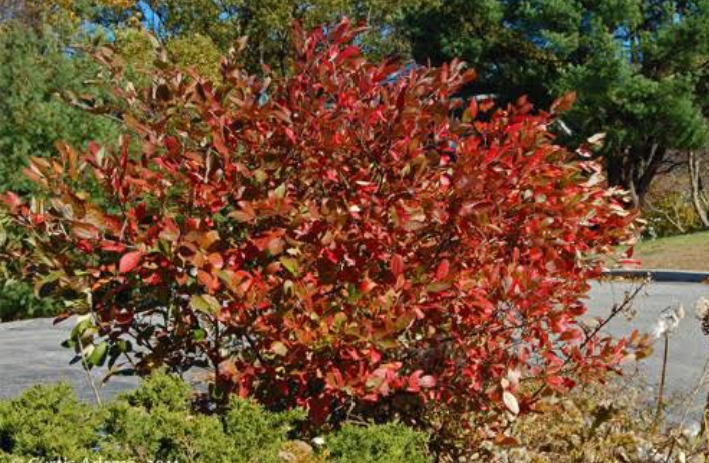
Black chokeberry, also known as Aronia melanocarpa, is hardy in USDA plant hardiness zones 3 through 8. It grows 3 to 6 feet tall and has a dense, spreading habit or leggy form.
The shrub also produces small, white flowers in late spring or early summer. The flowers have five petals and are cup-shaped, with a prominent center of stamens and pistils. The blooms last for about two weeks after they appear for the first time. After the flowers have been pollinated, they develop into small, purplish-black fruits.
The leaves are dark green in color during spring. In the fall, the leaves turn a vibrant red color. Black Chokeberry can create a dense hedge or used for border planting. It can also be incorporated into mixed plantings with other shrubs and perennials. It pairs well with plants such as hydrangeas, astilbes and hostas.
Also Read: Yellow Flowering Shrubs For Your Front Yard Garden
Other Facts And Data
| Scientific Name | Aronia melanocarpa |
| Size | 3 to 6 feet tall |
| USDA Zones | 3-8 |
| Growth Rate | Moderate |
| Flowers | White |
| Native Area | North America |
| Toxicity | Not toxic |
Oakleaf hydrangea

The oakleaf hydrangea grows to a height of 6 to 8 feet. As the common name suggests, the leaves of this shrub resemble those of an oak tree, with deeply lobed, toothed edges and a pointed tip.
During the growing season, the leaves are dark green color in. In the fall, the leaves of Oakleaf hydrangea turn a beautiful shade of reddish-purple.
The plant produces large, conical flower clusters. The flowers start out white, but as they age, they turn pink and then a deep, rusty red. Oakleaf hydrangeas are hardy in USDA zones 5 to 9, and can be grown in full sun to partial shade.
You can grow Oakleaf hydrangea as an accent in the front yard. Plant it in an easily visible place, such as near the front door or at the corner of the house, to draw attention to its beauty. For front yards with limited space, grow it in containers or in groups with other shrubs, perennials and annuals.
Other Facts And Data
| Scientific Name | Hydrangea quercifolia |
| Size | 6 to 8 feet tall |
| Growth Rate | Fast |
| USDA Zones | 5-9 |
| Flowers | White |
| Native Area | Southeastern United States |
Ninebark
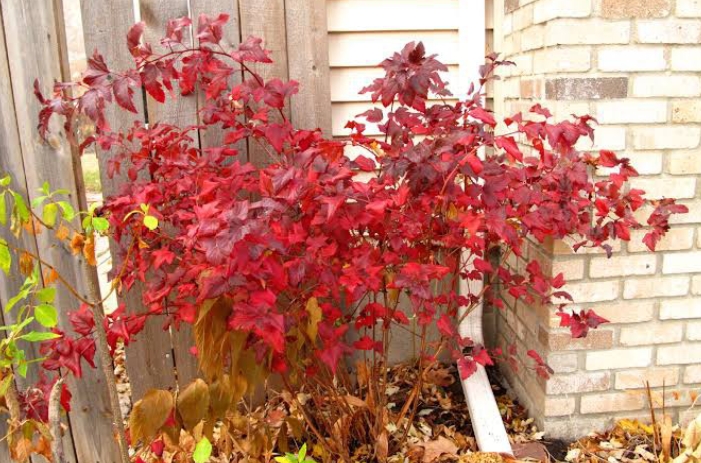
Ninebark shrub also known as Eastern Ninebark, Common Ninebark or Bush Cinquefoil. It is a medium to large shrub that grows to a height of about 6 feet. It is multi-stemmed habit with a dense, bushy growth habit.
During the growing season, the leaves are simple and dark green in color, but some cultivars have variegated or purple foliage. In the fall the leaves are usually quite spectacular, in shades of bright red color or orange with hues of red.
Ninebark is hardy in USDA zones 3-7, which includes much of the northeastern and north-central United States, as well as parts of the Pacific Northwest. In these zones, Ninebark can withstand the cold temperatures and harsh winter weather that are characteristic of these regions.
In a front yard, Ninebark shrub can be used as a naturalistic planting, where it can be combined with other native plants to create a more wild and naturalistic look. It can also create a hedge along a property line or to define other outdoor space in very many ways.
Other Facts And Data
| Scientific Name | Physocarpus opulifolius |
| Size | 4 to 6 feet tall |
| USDA Zones | 3-7 |
| Flowers | White or pink |
| Native Area | North America |
Burning Bush shrub

The Burning Bush shrub, also known as winged spindle tree. The shrub is dense, multi-stemmed and grows to a height of 6 to 9 feet. Its stems are covered with distinctive corky ridges, or “wings,” that run along the length of the branches. These wings are more pronounced on older branches.
The leaves are simple, dark green and shiny during the growing season, and in the fall, they turn a vibrant shade of red. The flowers are small and greenish-yellow and bloom in late spring or early summer, followed by small reddish-pink fruits.
This is slow-growing plant, taking several years to reach its full size. It is also a low-maintenance plant. It can be trimmed back in late winter or early spring to maintain its shape and encourage new growth.
The shrub is hardy in zones 4-8, that means it can tolerate minimum winter temperatures of -30°F to 20°F. In zone 4, which includes areas such as Montana and Maine, the Burning Bush may need some winter protection to survive. In warmer areas such as zone 8, which includes parts of Texas and Georgia, the plant may benefit from some afternoon shade to protect it from the hot sun.
Other Facts And Data
| Scientific Name | Euonymus alatus |
| Size | 6 to 9 feet tall |
| USDA Zones | 4-9 |
| Growth Rate | Slow |
| Flowers | Greenish-yellow |
| Native Area | North America |
| Toxicity | Toxic to dogs, cats and horses |
Red-Osier dogwood
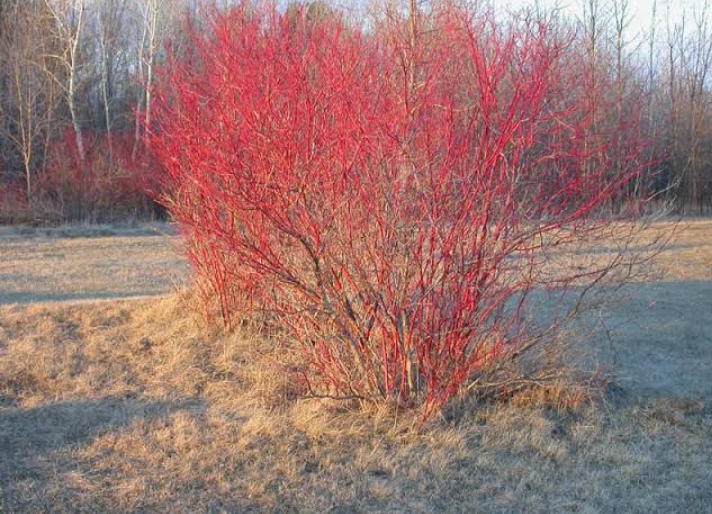
The Red-osier dogwood grows to a height of 7 to 10 feet tall. It has green-red branches and twigs that become all bright red or maroon in winter when the leaves have fallen off (hence the tree’s name). Individual plants start as multiple stems from the ground and are heavily branched higher up.
The flowers are small and white, clustered in flat-topped inflorescences that appear in late spring or early summer. In the fall it also produces whitish-blue or purple clustered drupe.
Red osier dogwood is also sometimes known as red-stemmed dogwood or redtwig dogwood. It is hardy in USDA hardiness zones 2 through 8, though it will likely grow better in colder and wetter climates in zones 7 and below.
The red osier dogwood grows in a loose branching formation, with upright stems and horizontal branches. It is quick growing in nature. In your yard you can use it as a border plant to line walkways, driveways or garden beds.
Also Read: Different Types of Evergreen Shrubs
Other Facts And Data
| Scientific Name | Cornus sericea |
| Size | 6 to 9 feet tall |
| USDA Zones | 7-9 |
| Growth Rate | Quick |
| Flowers | White |
| Native Area | North America (United States) |
| Toxicity | Not toxic to humans, but can be a concern for livestock, such as cattle, horses and sheep. |
Staghorn sumac

Staghorn sumac, also known as Rhus typhina, is a shrub or small tree. It is native to North America and can be found in the eastern and central parts of the continent. It can grow up to 15 feet tall, but more often in home yards, it stays under 10 feet. In warmer zones, it can grow taller and may take on a more tree-like appearance.
Staghorn sumac leaves are compound in nature. In the fall, the leaves turn a brilliant red or red-orange in color. The flowers are small and greenish-yellow and are arranged in dense, upright clusters. They are produced in early summer.
After flowering, the shrub produces bright red, fuzzy fruit clusters in late summer that persist through the winter. These clusters are made up of small, red berries that are covered in fine hairs.
This shrub is hardy in USDA zones 3 through 8, which cover most of the eastern half of the United States. In zone 3, which includes areas with minimum temperatures as low as -40°F (-40°C), the plant stays as a shrub and does not grow beyond 6 feet.
Give that this shrub has a unique branching structure and upright growth habit, you can grow it in the most visible part of your front yard to act as an accent plant that draws attention of visitors.
Also Read: Different Varieties of Viburnum Shrubs
Other Facts And Data
| Scientific Name | Rhus typhina |
| Size | 10 to 15 feet tall |
| USDA Zones | 3-8 |
| Growth Rate | Fast |
| Flowers | Greenish Yellow |
| Native Area | North America (United States) |
| Toxicity | Non-toxic |
Arrowwood Viburnum
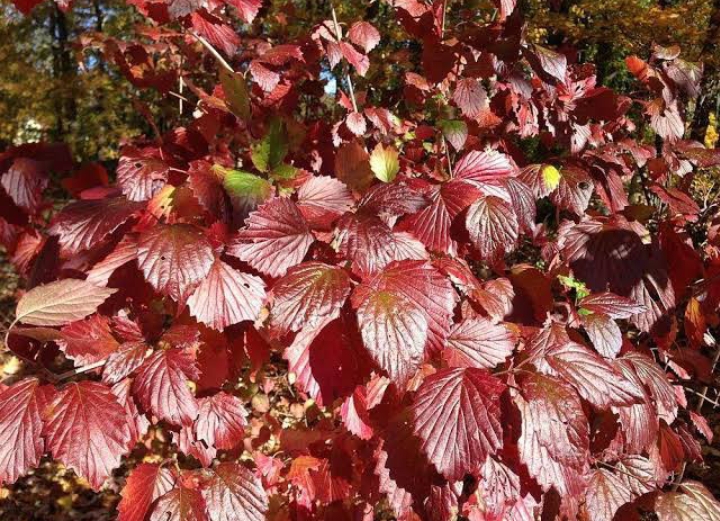
Arrowwood Viburnum is native to North America. It is a multi-stemmed shrub that can reach a height of 8 to 10 feet. The shrub has an upright, spreading growth habit and develops a dense crown. It is a good shrub for growing in a front yard or along the fences and walkways of your homestead.
The leaves of Arrowwood Viburnum are simple in nature. In the spring and summer, the leaves are a vibrant green and, in the fall, they turn a deep red to purple-red color. In late spring to early summer the shrub produces creamy-white flowers. The flowers are arranged in flat-topped clusters.
Arrowwood Viburnum is hardy in USDA zones 3 through 8. This means that it can withstand winter temperatures as low as -40 degrees Fahrenheit in zone 3 and as high as 20 degrees Fahrenheit in zone 8. In generally this shrub is considered to be non-toxic to humans and pets.
Other Facts And Data
| Scientific Name | Viburnum dentatum |
| Size | 8 to 10 feet tall |
| USDA Zones | 3-8 |
| Growth Rate | Fast |
| Flowers | Creamy-white |
| Native Area | North America |
| Toxicity | Non-toxic |
Highbush blueberry
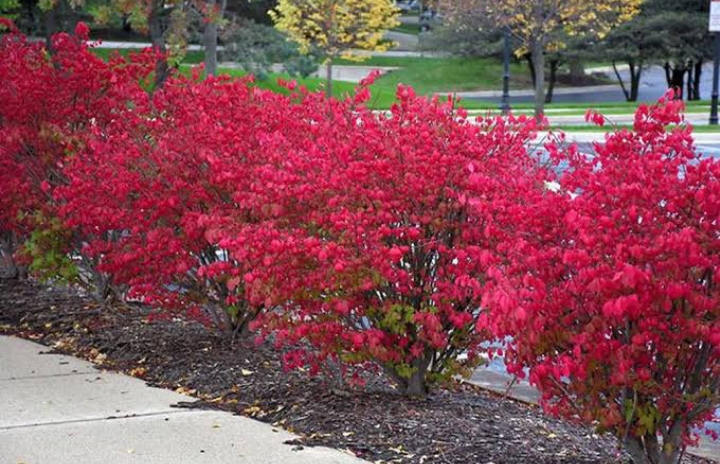
Highbush blueberry is native to North America. It is commonly found in the eastern and northeastern parts of the United States, southeastern Canada, and some parts of the Midwest. It grows up to 10 feet tall but its average size is around 6 feet in height when growing in home gardens.
The leaves of the highbush blueberry are simple. The leaves are dark green on the upper surface and lighter green on the lower surface. In the fall, the leaves tend to display bright and vibrant red hues.
The highbush blueberry shrub produces white or pinkish flowers in the spring, which are followed by blueberries in the summer. The fruit is plump with a smooth skin and a juicy flesh.
The shrub is most suited to USDA zones 4-7, which correspond to the areas with a minimum temperature range of -30°F to 5°F. These zones cover most of the northeastern and north-central regions of the United States, including parts of New England, the Midwest and the Pacific Northwest.
In your front yard garden you can use the shrub as an edible landscape plant because it produces sweet berries that can be harvested and eaten fresh. You can also use it as a privacy screen or hedge in a front yard garden.
The shrub also produces abundant and scented flowers that attract beneficial insects such as bees, butterflies and hummingbirds, which help to pollinate other plants in the garden and promote biodiversity.
Other Facts And Data
| Scientific Name | Vaccinium corymbosum |
| Size | 4 to 10 feet tall |
| USDA Zones | 4-7 |
| Growth Rate | Fast |
| Flowers | Pink flowers |
| Native Area | North America (United States) |
| Toxicity | Non-toxic |
Red Chokeberry

Red Chokeberry is native to eastern North America. It is a multi-stemmed shrub that grows between 6 to 10 feet tall. In North America very many people love it and use it for landscaping purposes due to its attractive foliage and showy fruit.
This is a slow-growing shrub and may take several years to reach its full height. The leaves are dark green in color during the growing season. In the fall, the leaves of the turn a brilliant shade of red.
Red Chokeberry blooms in mid to late spring, producing clusters of white flowers with a pinkish tint. The flowers are followed by bright red berries in the late summer to early fall, which persist into the winter months.
This shrub can tolerate extreme cold temperatures. It is well-suited for USDA Hardiness Zones 4 to 9. In Zone 4, which includes areas of the northern United States such as Maine, Minnesota and Montana, winter temperatures can drop as low as -30°F.
In warmer climates, such as Zone 9, which includes southern states such as Florida, Texas, and Arizona the shrub is still able to adjust to heat and humidity.
This shrub work well as an accent plant when planted as a solitary specimen in a garden bed or mixed border. It can also be planted in a row to create a hedge. For gardeners with limited space, it still can be grown in containers.
Other Facts And Data
| Scientific Name | Aronia arbutifolia |
| Size | 6 to 10 feet tall |
| USDA Zones | 4-9 |
| Growth Rate | Slow |
| Flowers | White |
| Native Area | North America |
| Toxicity | Non-toxic |
Smooth Sumac
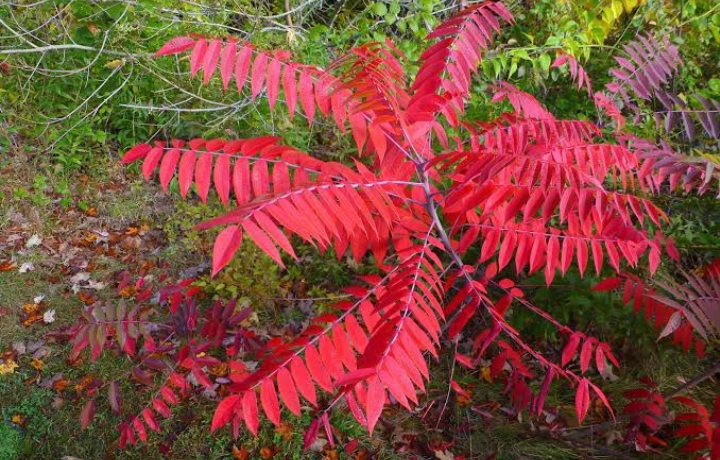
Smooth Sumac belongs to the same family with plants such as poison ivy, poison oak and cashews. It is native to eastern North America, that is from southern Quebec to Florida and west to Texas. The shrub can grow up to 15 feet tall.
The leaves of the Smooth Sumac are compound in nature. The leaves turn a brilliant red in the fall. The shrub blooms in late spring or early summer, producing greenish-yellow flowers in dense clusters. The flowers are followed by clusters of fuzzy, bright red berries that ripen in late summer or early fall. The berries are edible and have a tart flavor that is similar to that of lemonade.
Smooth Sumac can tolerate growing conditions such as USDA Zones 3-9. Though in zone 9, it may somehow struggle with the heat and humidity and may require more water and shade to thrive.
Other Facts And Data
| Scientific Name | Rhus glabra |
| Size | 6 to 15 feet tall |
| USDA Zones | 3-9 |
| Growth Rate | Slow |
| Flowers | Greenish-yellow |
| Native Area | North America |
| Toxicity | Non-toxic |
The Mountain Witch Alder

The Mountain Witch Alder is native to the southeastern United States. It grows to a height of about 8 feet with rounded form and is densely branched. The leaves are dark green in summer and turn shades of orange-red or just red in the fall.
In spring, the shrub produces bottlebrush-like flowers that are white or pale pink in color. The flowers have a honey-like fragrance that is attractive to bees and other pollinators. The shrub can be grown as a specimen plant or in groupings, and is also fine when used as a hedge or border plant.
Mountain Witch Alder is hardy in USDA Zones 4-8, which means it can tolerate average winter temperatures down to -30°F (-34°C).
Other Facts And Data
| Scientific Name | Fothergilla major |
| Size | 4 to 8 feet tall |
| USDA Zones | 4-8 |
| Growth Rate | Moderately fast |
| Flowers | White or pale pink |
| Native Area | North America (United States) |
| Toxicity | Non-toxic |
Serviceberry

Serviceberry, also known as Amelanchier, is a shrub or small tree that is native to North America, Europe and Asia. This multi-stemmed shrub can spread 10 to 15 feet and sports a narrow, open crown with numerous suckers that can form a thicket. Most varieties of serviceberry are smaller and more shrub-like.
Young serviceberry leaves are purple or greenish-gray, but mature to dark green. They turn reddish-orange in the fall. The flowers are white or pink and appear in early spring, before the leaves. The fruit is a small berry that can be red, purple or black when mature.
Most varieties of serviceberry can be grown in zones 4-9, although some varieties can tolerate colder temperatures and can be grown in zones 3 or even 2.
Plant the shrub in a visible place such as near the entrance or in the center of the yard, where it can be easily seen and appreciated. You can as well pair it with other plants such as evergreens or perennials to create a natural mix border in the front yard.
Other Facts And Data
| Scientific Name | Amelanchier |
| Size | 10-15 feet tall |
| USDA Zones | 4-9 |
| Growth Rate | Slow |
| Flowers | White or pink |
| Native Area | North America |
| Toxicity | Non-toxic |